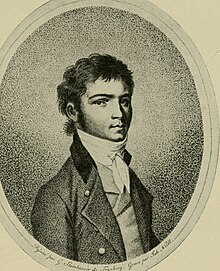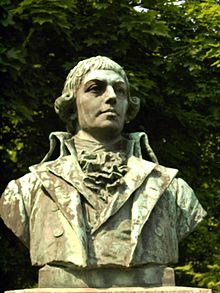Seufzer eines Ungeliebten – Gegenliebe
Seufzer eines Ungeliebten – Gegenliebe (Sigh of an unloved one – Love requited), WoO 118, is a song (lied) for voice and piano by Ludwig van Beethoven, composed at the end of 1794 or in 1795. The text comes from two related poems from the collection Lyrische Gedichte (1789) by Gottfried August Bürger.[2] Both poems are written from the point of view of young man experiencing unrequited love: "Seufzer eines Ungeliebten" expresses the conceit that while all the creatures of the woodlands and fields have a partner to love them, the young man has none; "Gebenliebe" expresses a blissful fantasy on the young man's part that his love is returned.


Composition and publication history
editThe composer was about 24 when he wrote the song; he had arrived in Vienna in 1792 to study and build his career. Beethoven's primary teacher in Vienna was Joseph Haydn, who had himself already set the "Gegenliebe" poem to music (1784,[3] Hob. XVIIa: 16). Beethoven also studied with Antonio Salieri, who helped him in his goal of becoming an opera composer.[4] Beethoven's sketches for "Seufzer/Gegenliebe" are mixed with that of another song about unrequited love, Adelaide, which unlike 'Seufzer/Gegenliebe' was published at the time and was quite successful. It is unknown whether Beethoven attempted to publish "Seufzer/Gegenliebe" at the time of its composition. Much later in his lifetime, Beethoven offered the song to the publisher Peters of Leipzig, in a letter from 5 June 1822,[5] but in the end it was published only posthumously (1837) by Anton Diabelli.[6] The work appears today in standard editions of Beethoven's songs and is occasionally performed and recorded.
"Seufzer/Gegenliebe" and Beethoven's own life experience
editAs his friend Franz Gerhard Wegeler later remembered, Beethoven's composition of love songs coincided with a time that he himself was frequently in love:
"In Vienna, at least for as long as I lived there, Beethoven was still engaged in romantic relationships, and at that time he had made conquests which would have been very difficult, if not impossible, for more than one Adonis. - Can a man, without having known love in its most intimate mysteries, have composed Adelaide, Fidelio and so many other works? […] I will note again that, as far as I know, all the objects of his passions were of a high rank."[7]
However, the fact that "all the objects of his passions were of a high rank" was problematic, as biographers such as Jan Swafford have pointed out: it was quite inappropriate for a commoner like Beethoven to form a love match with an aristocratic woman, and indeed Beethoven never succeeded in his life in creating a permanent romantic attachment; he died unwed. Hence it is possible that the sorrows and wishful thinking given in Bürger's poems resonated with Beethoven's own feelings.[8]
Text
editBeethoven encountered Bürger's poems in their published form in the Göttingen Musen-Almanach.[9] Originally, it appears that Bürger wrote the poems separately, then realized their connectedness and had them printed in subsequent editions adjacently, in the order Beethoven encountered.
As can be seen in the text below, Beethoven altered Bürger's words in minor ways.
|
|
|
|
|
|
|
|
|
|
|
|
|
|
|
|
|
|
|
|
Meters
editSeufzer eines Ungeliebten is composed in iambic tetrameter, with the first line of each couplet including an extra final unstressed syllable, so the lines alternate between 9 and 8 syllables. This is a widely used pattern, seen for instance in Goethe's poem Wilkommen und Abschied. "Gegenliebe" is in a version of trochaic tetrameter in which half of the lines are catalectic; i.e. they omit the final eighth syllable.[note 1] In both poems, the lines are grouped into quatrains with rhyme scheme ABAB.
The music
editThe song reaches the A above middle C and thus is suited to be sung by a tenor (or, in principle, a soprano) voice. Other singers have sung the work transposed; for instance, the baritone Dietrich Fischer-Dieskau recorded the work in A minor, a minor third lower than notated.[13]
Pilcher (2021:75) calls the song "formally adventurous," and it is indeed unusual for a composer to incorporate two poems into the same song.[note 2] Beethoven sets the first stanza of "Seufzer eines Ungeliebten" with recitative, of the kind widely used in opera. Following the recitative comes the main portion of "Seufzer eines Ungeliebten," in a leisurely 3/4 rhythm, marked andantino. This main portion ends not with a tonic cadence, but a loud dominant chord with fermata, making it clear that more is to come. Without pause there follows Beethoven's setting of "Gegenliebe", in 2/4 time with a faster tempo (allegretto).
Cooper (1994) has put forth a distinction among Beethoven's songs: some are "folk-like", with each stanza given a fairly simple setting; others involve a "dramatic, even operatic approach"; "Seufzer/Gegenliebe" falls in the latter category. Orrey (1971), pursuing the same idea, notes that in Italian opera a soloist often would sing a recitative followed by a bipartite aria consisting of a slow passage, the cavatina, followed by a final faster section, the cabaletta; the three portions of "Seufzer/Gegenliebe" correspond to these three standard sections.
Cooper (2008:65) later offered a slight different analogy: the work is a "double song" set in the form of a "miniature Italian cantata." Historically, cantata and oratorio arias tended to follow operatic models.[14] The use of term "cantata" for a solo vocal work with piano would have been familiar in Beethoven's time; his contemporaneous song Adelaide, likewise operatic in style, was first published as a "cantata".[15]
The key structure of "Seufzer/Gegenliebe" is centered on the tonality of C. The recitative is in c minor, the rest of "Seufzer" mostly in E flat major (the relative major of c minor), coming to a close on c minor again, and "Gegenliebe" is in C major.[note 3] The shift from stormy c minor to exultant C major was a tonal pattern Beethoven would adopt again later on, in the Fifth Symphony (1808) and the last piano sonata (1822).
Influences on later work by Beethoven
editThe operatic style of "Seufzer/Gegenliebe", and the fact that Beethoven never published it, suggests regarding it as a sort of preparation for more prominent works he created later on. Thus, Orrey (1971) sees "Seufzer/Gegenliebe" as an early preparation for Beethoven's concert aria "Ah! perfido" (1796), a more extended work written for soprano solo and orchestra. "Ah! perfido" shares the recitative-cavatina-cabaletta structure of "Seufzer/Gegenliebe,"and its cavatina section is likewise in E flat and set in 3/4 time. As with "Seufzer/Gegenliebe," the text deals with "thwarted love" (Orrey). Further on, Pilcher (p. 128) notes that Beethoven deployed the recitative-cavatina-cabaletta structure of "Seufzer/Gegenliebe" in his only opera Fidelio (1805-1814); it is used for the major solo scenes of his protagonists, Leonore and Florestan.[note 4]
The melody of "Gegenliebe," given below, continued to evolve in Beethoven's mind as his career progressed.
Only slightly altered (with masculine rather than feminine endings), the theme appears in Beethoven's Choral Fantasy opus 80 for piano, chorus and orchestra, from 1808. The Choral Fantasy version is in turn widely viewed as a foreshadowing of the "Ode to Joy" melody employed in the final movement of the Ninth Symphony (1824).[2]
References
edit- Attridge, Derek (1982) The Rhythms of English Poetry. Burnt Mill: Longman.
- Cooper, Barry (1996) "Ludwig van Beethoven: Lieder". Program notes for the album "An die ferne Geliebte: Beethoven Lieder," with Peter Schreier (tenor) and András Schiff (piano). Decca Records.
- Cooper, Barry (2008) Beethoven. Oxford: Oxford University Press.
- Orrey, Leslie (1971) ‘The Songs’, in The Beethoven Companion, ed. Denis Arnold and Nigel Fortune. London: Faber and Faber, 411-42.
- Pilcher, Matthew (2012) Structure, rhetoric, imagery: Intersections of literary expression and musical narrative in the vocal works of Beethoven. Ph.D. dissertation, University of Manchester.
- Ronyak, Jennifer (2016) Beethoven within grasp: The nineteenth-century reception of 'Adelaide'. Music & Letters 97:249-276.
- Swafford, Jan (2014) Beethoven: Anguish and Triumph. Mariner Books.
- Youens, Susan (2008) Program notes for "Ludwig van Beethoven (1770-1827) Lieder und Gesänge", with Dame Ann Murray (mezzo-soprano), Roderick Williams (baritone), and Iain Burnside (piano). Hyperion Records. [2]
- Zimmer, Mark S. (2016) Liebe: the discovery and identification of a Beethoven song lost since 1822. The Musical Times 157:13-34.
Notes
- ^ The meter of "Gegenliebe" is, however, quite unusual in arranging its 8- and 7- syllable lines within couplets so that the shorter, 7-syllable line comes first in the couplet (i.e. "7 + 8" couplets). The norm for length-differentiated couplets is 8 + 7; see e.g. Attridge (1982:103). Beethoven partially repairs the metrical anomaly by assigning the last syllable of the 7-syllable lines two quarter notes, a melisma, thus approximating the normal 8 + 8. But Youens (2008) nonetheless remarks that "the prosody leaves something to be desired". In the later version of the "Gegenliebe" tune that Beethoven created for his Choral Fantasy (see below), the problem is resolved by using different poetry and altered music.
- ^ To be sure, in the song cycle a composer strings together a set of related songs into a single work; Beethoven himself was later a pioneer of the song cycle in his An die ferne Geliebte (1816). Ronyak (2016:216) toys with the idea of calling "Seufzer/Gegenliebe" a "two-song cycle", but ultimately opts for the opera- and cantata-based models described below.
- ^ Pilcher (p. 160) observes that Florestan's scene in Fidelio follows the same pattern, centered in this case on F.
- ^ Thus, at the start of the second act Florestan sings first of his despair in recitative in "Gott! Welch' Dunkel hier",[16] then his sense of duty in "In des Lebens Frühlingstagen" (tempo adagio, 3/4), and finally experiences an ecstatic hallucination of Leonore as a rescuing angel ("Und spür' ich nicht Linde", poco allegro, common time). Leonore's Act I scene is similar in structure. [17]
Sources
- ^ https://www.artexpertswebsite.com/services/portrait-id-beethoven.php
- ^ a b Jean Massin and Brigitte Massin, Ludwig van Beethoven, Fayard, 1967, p. 597.
- ^ https://imslp.org/wiki/Gegenliebe%2C_Hob.XXVI:16_(Haydn%2C_Joseph)
- ^ Swafford (2014)
- ^ For background and details of Beethoven's correspondence with Peters, see Zimmer (2016:13-16). Beethoven included the song in a price list, asking 12 gold ducats for it, evidently to no avail.
- ^ "Facsimile of the original edition". Archived from the original on September 15, 2018. Retrieved 1 January 2021.
- ^ Franz Gerhard Wegeler, Biographical notes on Ludwig van Beethoven, p. 43-447. In Franz Gerhard Wegeler and Ferdinand Ries, Biographische Notizen über Ludwig van Beethoven, K. Bädeker, Coblence, 1838, 164 p. Read on line
- ^ See e.g. Swafford, Jan (2014)
- ^ Pilcher (2021:19)
- ^ Original text :"in Hain und Wiesenmatten".
- ^ Original text : "Die Eine nur".
- ^ The German Eine is feminine gender; implying "only one woman".
- ^ Deutsche Grammophon Complete Beethoven Edition vol. 16; on YouTube at [1]
- ^ Discussion of aria structure, with examples
- ^ See Adelaide for original title page.
- ^ Translations for this footnote: "God! What darkness here," "In the spring days of life," "And do I not sense a gentle (breeze)"
- ^ Ludwig van Beethoven: Fidelio in Full Score, Dover Publications, 1984.
External links
edit- "Seufzer eines Ungeliebten" – "Gegenliebe": Scores at the International Music Score Library Project
- Recorded performance on YouTube, with simultaneous display of the score. Peter Schreier (tenor), András Schiff (piano)